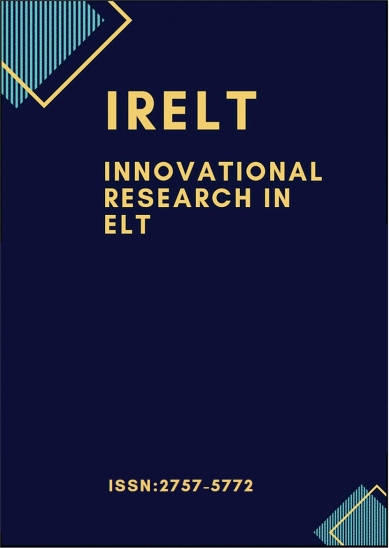Research article | Open Access
Innovational Research in ELT 2021, Vol. 2(1) 13-20
Teaching English as an International Language (TEIL): A Showcase of the Field
pp. 13 - 20 | DOI: https://doi.org/10.29329/irelt.2020.347.2
Publish Date: June 07, 2021 | Single/Total View: 266/985 | Single/Total Download: 350/2.239
Abstract
As an initiative to question the Anglo-centric view of English ignoring the socio-cultural realities, the paradigm of English as an International Language (EIL) has gained space in the scholarly realm. Despite the thriving body of literature on theory, action based studies seem to be largely missing. The main rationale underlying this article is to analyse eight EIL-oriented classroom implementations from the perspectives of practitioners around the world with the aim of not only deepening the understanding of EIL but also offering useful insights for practitioners who may find its assumptions documented at theory level too elusive to implement. Findings evidence pedagogical value including a true understanding and increased awareness of the sociolinguistic realities and complexity of English, positive attitudes towards its cultural and linguistic diversity, skill enhancement, and higher motivation and confidence in using English. The review ends with pedagogical implications and suggestions for further research.
Keywords: EIL, TEIL, classroom, ELT
APA 7th edition
Cetinkaya, S.E. (2021). Teaching English as an International Language (TEIL): A Showcase of the Field. Innovational Research in ELT, 2(1), 13-20. https://doi.org/10.29329/irelt.2020.347.2
Harvard
Cetinkaya, S. (2021). Teaching English as an International Language (TEIL): A Showcase of the Field. Innovational Research in ELT, 2(1), pp. 13-20.
Chicago 16th edition
Cetinkaya, Sakire Erbay (2021). "Teaching English as an International Language (TEIL): A Showcase of the Field". Innovational Research in ELT 2 (1):13-20. https://doi.org/10.29329/irelt.2020.347.2
Alptekin, C. (2002). Towards intercultural communicative competence in ELT. ELT Journal 56(1), 57-64.
Ayuthaya, J. R. N., & Sitthitikul, P. (2016). World-Englishes-based lessons: Their effects on anxiety and language achievement of Thai tertiary students. Arab World English Journal, 7(2), 201-223.
Bayyurt, Y. & Altınmakas, D. (2012). A WE-based English communication skills course at a Turkish university. In A. Matsuda (Ed.), Principles and practices of teaching English as an international language (pp. 169-182). Multilingual Matters.
Cogo, A. (2012). English as a lingua franca: Concepts, use, and implications. ELT Journal 66(1): 97-105.
Çelik, S., & Erbay-Çetinkaya, Ş. (2020). World Englishes and language teacher education. In S. Çelik & E. Solak (Eds.), World Englishes and culture in English as a foreign language (EFL) education (pp. 221-243). Vizetek.
Erbay-Çetinkaya, Ş. (2016). The effectiveness of an English as an international language (EIL)-oriented general English course: The perspective of a pracademic (Publication No. 460623) [Doctoral dissertation, Karadeniz Technical University]. Presidency of the Council of Higher Education, National Thesis Center.
Galloway, N., & Rose, H. (2018). Incorporating global Englishes into the ELT classroom. ELT Journal 72(1), 3-14.
Garcia, R. E. (2013). English as an international language: A review of literature. Colombian Applied Linguistics Journal, 15(1), 113-126.
Hino, N. (2012). Participating in the community of EIL users through real-time news: Integrated practice in teaching English as an international language (IPTEIL). In A. Matsuda (Ed.), Principles and practices of teaching English as an international language (pp. 183-200). Multilingual Matters.
Kirkpatrick, A. (2010). Introduction. In A. Kirkpatrick (Ed.), The Routledge handbook of world Englishes pp. 1-14. Routledge.
Lee, H. (2012). World Englishes in a high school English class: A case from Japan. In A. Matsuda (Ed.), Principles and practices of teaching English as an international language (pp. 154-168). Multilingual Matters.
Lee, J. S., Nakamura, Y., and Sadler, R. (2017). Effects of videoconference-embedded classrooms (VEC) on learners’ perceptions toward English as an international language (EIL). ReCALL 1-18.
Matsuda, A. (2012). Teaching materials in EIL. In L. Alsagoff, S. Lee McKay, G. Hu and W. A. Renandya (Eds.), Principles and practices for teaching English as an international language (pp. 168-185). Routledge.
Matsuda, A., & Friedrich, P. (2011). English as an international language: A curriculum blueprint. World Englishes 30(3): 332-344.
McKay, S. L. (2012). Principles of teaching English as an international language. In L. Alsagoff, S. Lee McKay, G. Hu and W. A. Renandya (Eds.), Principles and practices for teaching English as an international language (pp. 28-46). Routledge.
McKay, S. L. (2009). Pragmatics and EIL pedagogy. In F. Sharifian (ed.), English as an international language: Perspectives and pedagogical issues (pp. 227-241). Multilingual Matters.
Teixeira, A., and Pozzi, R. (2014). Introducing English as an international language in the inner-circle classroom: Exploring world Englishes. The CATESOL Journal 26(1), 50-59.
